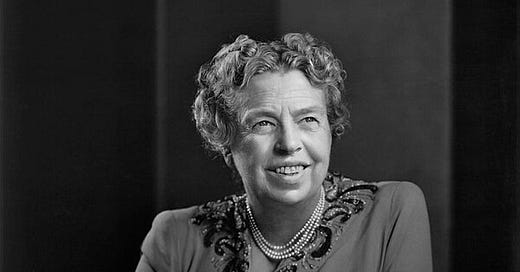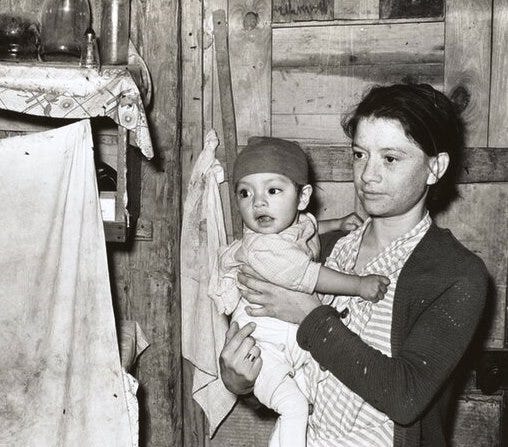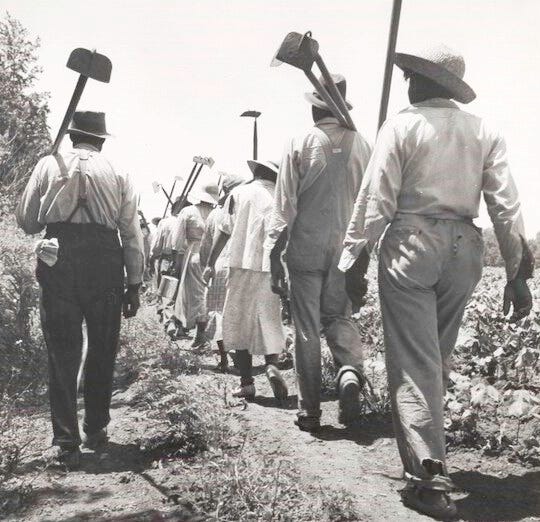Is history like a beach? Or is it like the untold millions of grains of sand that make up the beach? A historian’s job is to make sense of the dunes and bars and spits of the past. But we all live our lives at the level of the grains. We don’t experience history as movements or forces or trends. We only see the day-to-day in all its perplexing detail.
Once, on a tour of the Franklin D. Roosevelt Presidential Library and Museum in nearby Hyde Park, I was curious about several glass globes the size of baseballs mounted in metal frames near each door of FDR’s office.
It turned out that in 1884, when the future president was two years old, he was visiting his aunt. She was using an alcohol lamp to heat an iron to curl her hair. She accidentally knocked over the lamp. Her dress caught fire. She ran out of the house and later died of her burns. The toddler watched it happen, heard the screams.
Afterward, Franklin was always afraid of fire, a fear that increased after polio left his legs paralyzed in 1921. The globes in his office were extinguishers. Tossed like a hand grenade at a blaze, they exuded fumes that smothered the fire. An interesting grain of sand in the story of a man who said the only thing we have to fear, is fear.
During another visit to the FDR library, I read some of the letters that the president’s wife, Eleanor, received from strangers during his presidency. Well known and beloved, the first lady heard from thousands of Americans about their own fears, their problems, their hopes and dreams.
These letters are granular history. What historians call the Great Depression is only a concept. The reality consists of the experience of each of those whose life was shattered by a sudden plunge into poverty, by relentless worry and despair. A woman who is in desperate need of money writes to the president’s wife. She does not want a handout, only a loan. As a pledge that she will pay back anything she receives in aid, she sends along her wedding ring.
Many of the letters have a simple poetry to them. “Dear Mr. and Mrs. Roosevelt, Once more our blessed Christmas Day is over and with a sigh and tears to many, eyes so dim and the road so rough.” The writer, a woman of sixty-four, goes on, “I havent got the power but I have a heart of deepest sympathy and a real good knowledge of just and unjust.” Her purpose in writing is to complain about the “machenery” that is not just causing unemployment but serving to take “our working class who are among our best people and make paupers out of them.”
A woman from South Dakota with ten children has a clock “in good running order” and asks, “if you knew some rich old Genelman who would buy it to help me out.” Eleanor’s secretary prepared personal responses to each letter, expressing sympathy but usually saying that, because of the many requests for help, Mrs. Roosevelt “regrets she can do nothing.”
A Florida resident writes to thank Mrs. Roosevelt for advocating an “Old Age Security Act.” She cites the many who “have lost their small businesses, which means losing their bread and butter, and are walking into the sunset land with hidden horror in their hearts. The class of people who would starve before they would ask for aid.”
A young woman from Eureka, California, writes that she and her husband were “married on the proverbial shoe-string but with a wealth of love.” Her husband worked as a surveyor, but “then came the depression.” He lost his job, she became pregnant. “Tommy is nearly out of his head. He has tried every conceivable prospect but you must know how even pick and shovel jobs do not exist.” She concludes, “I shall hope and pray for a reply and tell myself that you are the busiest woman in America, if I don’t receive it.”
Superficial history can guess at the economic causes of the Crash of 1929 and the ensuing financial collapse. But real history is a man from Michigan who has only one arm and refers to Mrs. Roosevelt as “your Highness.” He has a wife and three children to support. He needs money to get to New York to “try out on the Major Edward Bowen amateur hour.” He writes, “all I can do is dance for a living.”
In November 1940, Mrs. Ruby Ogden, a widow and factory worker from Richmond, Virginia, writes Mrs. Roosevelt to say she is trying to raise her two daughters alone but doesn’t make enough to buy them decent clothes. She doesn’t see “where I can get the children anything for Christmas.” She feels that if she could get a small loan “I might some day in the near future be able to help some one just like my self, which I know there are thousands.”
Politicians like to bloviate about the “greatest generation” and to judge that such and such is “who we are as Americans.” But “who we are” is not a concept. It’s a reality. All those who were battered by hard times they did not create and who struggled through grueling years when hope was scarce, if we look at them not as a group, not as an idea, but as proud and resilient individuals — they are who we are.
Many of these letters are included in Cathy D. Knepper’s book, Dear Mrs. Roosevelt.







Thank you. These stories continue today around the world. But there was only one Eleanor Roosevelt. If she were alive today what would she recommend President Biden, V-P Harris and the Democratic Party do? I wish she were here to advise us again.
Take care and I love your writings.
Another good story Jack. I love Eleanor Roosevelt and her kindness to others. Our country is in a big mess and I'm always praying that at some point it will get better but at times it sure doesn't look like it.
We could use someone like her.